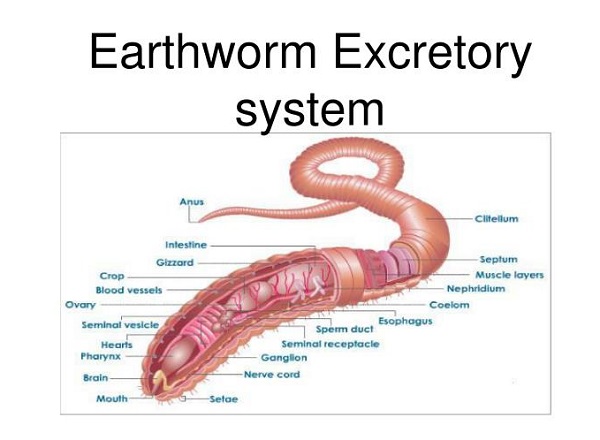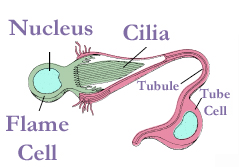Excretion is defined as the process by which toxic metabolic wastes are being removed from the body of a living organism.
Reasons for Excretion.
- To maintain water balance in the living organisms.
- To remove poisonous and unwanted substances from the body of the living organism.
- It helps in controlling body temperature.
- It helps to maintain salt balance (homeostasis).,
- It saves some protozoa such as amoeba from bursting.
| 1. Protozoa e.g. Amoeba | Body surface and contratile vacuole | CO2, water, excess mineral salts ammonia. | Contractile vacuole body surface. | Carbon (iv) oxide, water excess mineral salt and ammonia | ||
| 2. Flat worm e.g. Tape worm | Flame cell | Water,urea,CO2,urea and nitrogenous wastes. | Flame cell | Water, Urea, CO2 and Nitrogenous waste (ammonia) | ||
| 3. Annelids e.g. earthworm | Nephridium | Carbon-dioxide, urea and nitrogenous waste. | nephridium | Water, Urea, CO2 and nitrogenous wastes. | ||
| 4. Insects e. g Cockroaches | Malpighian tubule | Carbon-dioxide,water, and uric acid. | Malpighi an tubule | Water, CO2 AND Uric acid | ||
| 5.crustacea | Green gland | Carbon-dioxide, water and nitrogenous waste. | ||||
| 6.vertebrates.eg mammals,fish, lizard e.t.c | Lungs, kidneys,skin,liver | Water,carbon-dioixde,mineral salt,sweat,nitrogenous waste. | ||||
| 7.flowering plants | Stomata and lenticel | gum,mucilage Water,oxygen,carbon(iv)oxide,tannins,alide de alkaloid,lipid,latex,resins and oil. |
Explain the process of excretion in Amoeba.
Excretion in Amoeba is carried out by the contractile vacuole. Water constantly enters the amoebic cell through its selectively permeable membrane by osmosis. The excess water collects in a contractile vacuole. The contractile vacuole expands as it is filled with water and then empties its content to the exterior.
Excretory products, like ammonia and CO2 leave the Amoeba by diffusion across the selectively permeable cell membrane mechanism for excretion of metabolic wastes the surface area : volume is large for the amoeba.
EXCRETION IN PROTOZOA
Excretion in most protozoa is by contractile vacuole. This is a simple cavity found in the cell of fresh water protozoa that help to eliminate water from the cell. Some contractile vacuoles are spherical while others are star shaped. The cell membrane of protozoa such as amoeba is semi- permeable. The osmotic pressure inside the cytoplasm is greater than that of the water surrounding its water plasma. As water enters into the cytoplasm, a contractile vacuole is formed and water flows into it when it reaches, the maximum size it contracts and discharge the excess water through a temporary break in the cell membrane at regular intervals. Excretion of waste product such as carbon dioxide and ammonia is by diffusion through the cell membrane.
EXCRETION IN EARTH WORM

STRUCTURE OF A NEPHRIDIUM
Nephridia are the organ of excretion in earthworm. A pair of nephridia is located in each segment except the first three and the last segment. Each nehridridium consists of five (5) portions namely: nephrostome, , narrow tube, middle tube, , wide tube and muscular tube. The nephrostome is ciliated and funnel shaped and it lead to a narrow coiled and ciliated tube which in turn lead to middle ciliated tube .. The middle ciliated tube finally leads to muscular bladder- like tube with an opening to the exterior by the nephridiopore.
MECHANISM
Each nephrotome is located in the body cavity. The gut muscles in the body cavity is lined with CHLORAGOGENOUS cell deaminate unwanted amino acid into urea and GUANIN and other compounds. The waste nitrogenous compounds are secreted into the fluid of the body cavity. The fluid therefore contains both useful material (Glucose) and waste material (urea). The beating of the cilia of nephrostome draws the fluid which is pushed along the tube by the cilia and muscular contraction. As the fluid passes along the tube,useful materials such as glucose is reabsorbed into the blood circulation. Also, some nitrogenous compounds are absorbed by the secretory cell of the tubule. Finally, the waste fluid is pushed into the muscular bladder where it is temporarily stored before being discharged to the outside through the nephridiopore. Carbon (iv) oxide is excreted from the body by diffusion through the moist skin.
EXCRETORY SYSTEM IN FLATWORM STRUCTURE OF FLAME CELL.

The excretory organ in flat worm is called flame cell which consists of two longitudinal canals with network of ducts. The ducts branch to all parts of the body and end up in flame cells. The two main canals open on the dorsal surface of the body by excretory pores. Each flame cell is a bulb cavity and funnel shaped. Projecting from the cell lumen is a brush of long cilia. The cell lumen end up as a narrow tube called duct. The beating of the cilia resemble a flame which give the entire structure the name flame cell.
MECHANISM
Liquid wastes containing Ammonia and Carbon(iv)oxide diffuse into the cell lumen. The continuous beating of the cilia drives the wastes into the excretory duct and from there to the excretory pores on the surface of the body where they are eventually removed. Flame cells are found in flat worms such as Schistosoma, Planaria and Tapeworm.
EXCRETORY SYSTEM IN INSECT
The Malpighi an tubule is the excretory system in insect. They arise from the junction between the mid gut (small intestine) and hind gut (large intestine). Each tubule consists of two parts namely: distal end and proximal end. The distal end is free and closed. Malphighian tubules are lined with glandular epithelium and are arranged in group of six. The tubules lie in the body cavity called haemocoel where it can be bathed with blood.
MECHANISM
Since, the Malpigh an tubules are already laid in the haemocoel of insects, soluble nitrogenous wastes such as potassium urates are produced by the tissue of the insect and sent to the blood. The distal end of the tubule absorb the potassium urates from the blood. Inside the tubules, the potassium combines with carbon(iv)oxide and water to produce potassium and sodium bicarbonates and uric acid. These waste products move along to the proximal end of the tubules, where the bicarbonates and the water are reabsorbed, leaving the concentrated crystalline uric acid which is passed to the hind gut to mix with faeces. The uric acid are then again passed into the rectum where water is reabsorbed again.
The dry faeces and uric acid are passed out through the anus.

FORMS IN WHICH WASTE PRODUCTS ARE EXCRETED
Liquid form
Waste product which are of liquid form include water, uric acid, sweat, urea, urine, dissolved nitrogenous wastes, dissolved mineral salt, latex and gum.
Gas form
Waste product which are excreted in gaseous form include carbon(iv)oxide, oxygen and ammonia gas.
Solid form
Waste products which are excreted in solid form include uric acid in some animals tannin, alkaloid, mucilage in all plants.
Read our disclaimer.
AD: Take Free online baptism course: Preachi.com 